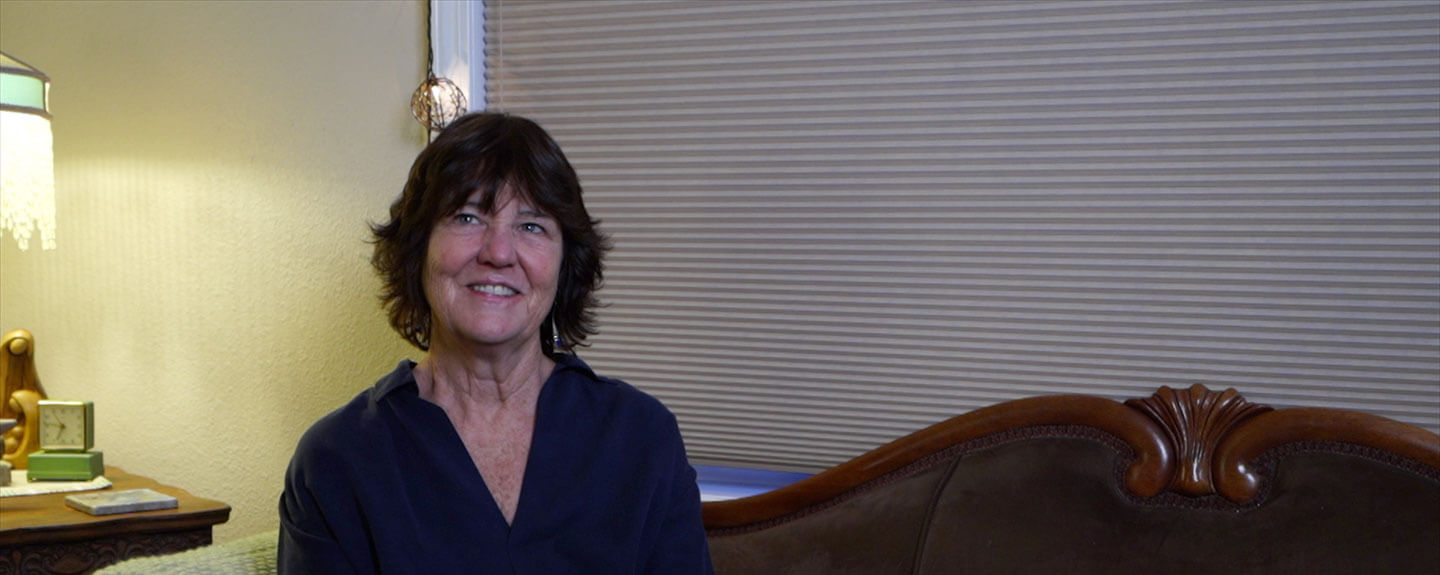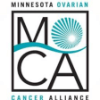When Mary Rita Ely was told that she might have ovarian cancer, she was in shock. “You f***ing have to be kidding me!” She exclaimed to her doctor. “I’m better than that!” She had always been active, eaten well, and been healthy. The night before her appointment, Mary Rita and her daughter, Tess, had looked up their life expectancy through AARP. “Wow, I’m going to live forever,” she declared. It was the last thing she remembered saying that night.
There was something she didn’t know. She had ovarian cancer, the fifth deadliest cancer for women in the United States.
Mary Rita is a passionate teacher with more than 30 years of experience working in special education. As a self-proclaimed “sun person,” she spends as much time as possible outdoors with her family, until she received her unexpected diagnosis in August of 2006. She was 51 years old, and she had just finished a marathon the December prior. Her spring was an active one. She remodeled her home with her three teenage children and she continued running well into the summer. It wasn’t until Independence Day that she first remembers “sitting out” for anything. She was on vacation with her kids. They had a good time playing volleyball, but she wasn’t diving for the ball. It simply hurt too much.
Mary Rita later went on a coffee date with her niece. Although she loved coffee, she didn’t really want any. Her niece later recalled this event to Mary Rita as strange. Another time, she went on a dinner date to a Thai food restaurant, but she hardly touched her food, despite being a big eater. She felt full. On an end-of-summer camping trip with her kids, Mary Rita really didn’t feel great. The first night in the tent, she realized that she couldn’t lay down any more, she was in so much pain. She remembers feeling full then, too.
When she got back home, Mary Rita went in to see a local doctor who took x-rays and had her do some bloodwork. It was the beginning of the school year and she was very busy as the facilitator coordinator of the seminar school. Mary Rita received a call. “The amylase in your pancreas is very high and I would like to get you in to see a GI doc,” her doctor said. It was a week before she could get an appointment, and when she did, the doctors told her that she should take something for constipation. “I knew it really wasn’t that,” Mary Rita says. A nurse suggested she visit the E.R. for another opinion.
Mary Rita brought work with her to the emergency room. “I thought I was just going to check out what was going on,” she says.” I didn’t think about the worst-case scenario.” A doctor gave her an exam, and pressed into Mary Rita’s stomach. “Does it hurt more when I press down or when I let up?” the physician asked. To Mary Rita’s surprise, it hurt more when the doctor let up. She was impressed by the amount of attention the doctor paid to her abdominal area. After the exam, the doctor sent her in for a CAT scan. However, when the doctor returned to the room with a nurse by her side, Mary Rita knew something was up. The doctor said, “Could you call your husband and get him here? We have some news.”
Mary Rita’s husband, Craig, was a wildlife biologist. He was back from the field and out hunting with the kids. Mary Rita had at first been oblivious, and even aggravated, with her visit to the doctor. All she could think was, “This is inconvenient. I have work to do. It’s a sunny day. The guys are out having a good time and I’m stuck in the hospital.” Now, the mood had changed and everything was suddenly becoming a lot more serious. She called someone she could trust, the OBGYN who had delivered her kids. She felt relief when he arrived. He knew her whole medical history and he was resourceful.
Mary Rita told the doctor to tell her what was going on before her husband got there. “You may have ovarian cancer,” she said. That was when the expletives started firing. Mary Rita not only shocked, but flabbergasted. She had a friend who had passed away from ovarian cancer six years prior and she knew everything her friend had gone through. She didn’t suspect her diagnosis at all. “I have a high tolerance to pain,” she explains, looking back at it. “I’m active. I wasn’t feeling as peppy as I used to but I am a middle-aged woman. There was a reasonable explanation for everything.”
When Craig arrived, they both felt relieved. “’Oh, thank God,’ he said, ‘It’s ‘just’ ovarian cancer, not pancreatic cancer.’” Mary Rita laughs when she recalls his reaction. Both of them remained incredibly positive during the first few moments of the diagnosis. “I’m one of those people that’s like, okay, here we go, now what? Let’s get the job done,” she says. She asked Craig to take their three kids to a friend’s house until they could figure out what to do. “The hardest part was arriving at the house to tell them,” she says. Her daughter Tess was 18 years old, and just one week away from going to college on the East Coast. “And how much do you tell a 16-year-old and a 13-year-old without scaring them?” Mary Rita says. “We still didn’t know too much ourselves.”
They talked to Tess first. Their friend sat beside them. They let her know what the diagnosis was, and that Mary Rita was going to see a doctor and that she was going to have surgery. “We’re going to do whatever we need to do,” they said. Tess knew Mary Rita’s OBGYN, and Mary Rita told Tess that he said she was doing fine otherwise. Mary Rita felt like they were in it together (but Tess has a different story, which you can read here). The next 72 hours were a whirlwind. Mary Rita went to the school and talked to the principal, got her substitute teachers lined up, and got everything in order. Her OBGYN called the local leading expert in gynecologic oncology. She met the surgeon, and just three days after receiving her diagnosis, she had the surgery.
“I felt good about it because my husband’s family is in the medical field,” she says. “They did some quick research and found out that the doctor was well-known, nationally recognized, and really well qualified for what she was about to do. With ovarian cancer, the first surgery is really important. I felt fortunate that I didn’t have to go through this period of angst and trying to figure out what to do. It was all laid out for me.”
Mary Rita spent a week in the hospital. The surgeon removed everything they could, including the spleen tumor, through a process called “optimal debulking.” As much as possible, the surgeon scraped clean everything in the surrounding area inside Mary Rita’s body. While she was in hospital, Mary Rita developed a blood clot in her lungs, and had to take blood thinners. Her family came up to Alaska to visit her. When she returned home from the hospital, a girlfriend came over to her house to help. Mary Rita was so sore that she couldn’t turn over in bed on her own. Despite being a long-distance runner, she could hardly walk a few steps. She had a lot of support, including from her daughter Tess, who decided to stay home from college.
After the surgery, it was time for Mary Rita to consider her treatment options. Her husband Craig found a treatment that had been out for 20 years called intraperitoneal (IP) chemotherapy, which delivers the chemotherapy drugs directly into the abdominal cavity via a catheter. He found a doctor who had been perfecting the technique at the Swedish Cancer Institute in Seattle. So began Mary Rita’s travels between Anchorage and Seattle.
She had a chest port installed, and she received one round of chemotherapy treatment in Alaska before flying down to Washington to have an abdominal port installed and to start IP treatment. For six months, she traveled to Seattle for periods of ten days to receive her chemotherapy. Fortunately, her cousins had recently purchased an empty apartment in Seattle that Mary Rita could stay in while she was on what her family called “chemo vacation.”
She recalls on a few distinct memories from this season of her life.
First, she recalls a night in the hospital when two young, male nurses walked into the room in hazmat suits to protect themselves from the chemotherapy drugs that Mary Rita was receiving, which were particularly toxic. It was necessary, but a slap in the face. Despite the toxicity of her drugs, Mary Rita never got nauseated. “It was grueling, but the doctors and nurses had refined the process,” she says. “It worked well for me and I was able to stay down there.”
She’s a positive person, but she also admits she’s stubborn. She knew she had to stay around for her three teenage kids. Mary Rita’s family came down to Seattle to spend time with her as much as they could. She thought of her friend who had passed as a role model. “She lived life to the fullest and she tried to live for her daughter,” Mary Rita says.
She also recalls lying in bed in her cousin’s empty apartment at night, looking out the windows that faced the Mercer Island bridge and staring at the lights. When she was there alone, she would think about what was going to happen to her kids. “I couldn’t dwell on it,” she says. “I had friends I could talk to. I didn’t talk so much with Craig and the kids because they were trying to survive too. In retrospect, it may have been better to talk more. My mindset was, how can I pay attention when I’m home to grades and friends and still be a mom?” It was a tough time for the family. They tried family counseling, they relied on their network of friends, and Mary Rita says she and her husband depended on Tess a lot during her treatment.
Today, Mary Rita is clean with no evidence of disease after coming clean from her first diagnosis, and being rediagnosed with ovarian cancer four years later. “I am extremely grateful,” she says. “I must have some kick-a** genes and I have incredible support. I can do yoga, workout, and eat whatever I want. It will probably come back, hopefully it doesn’t, but I do regular bloodwork, all of my treatment has worked, and I still have a lot of treatment options left. Not everyone has that option. A lot of people have bowel or intestinal involvement and chemotherapy doesn’t work for everyone.”
Mary Rita retired from teaching in 2007, but that doesn’t stop her from staying involved. She works part time at Benny Benson Secondary School in the Anchorage School District, improving the social and emotional learning at the school through changes to the environment. Her passion is working with children who are at-risk and assisting teachers with professional development. “I’ve been teaching for a long time and getting to know the families,” she says, “In this community that we live in, there are a lot of hurting students and families. It is important to provide them with the resources they need.”
Mary Rita recently did a one-day workshop called “Change of Heart” where they talked about diversity and stereotypes. She is also currently doing suicide awareness workshops at her school to break open old stereotypes related to depression and suicide. “I don’t mind talking about the hard topics,” she says. “With young people, there aren’t enough adults in their lives that have the time to listen. I feel like I have that time.”
Mary Rita is also actively involved in supporting other women who are going through ovarian cancer, educating the public, and raising awareness. She takes calls from friends and the family members of friends who are diagnosed with ovarian cancer to provide counseling. “I have quickly become the woman in Anchorage who is still alive and had ovarian cancer,” she says. “They use me as a reference. Now there are a lot more living women.”
When Mary Rita was diagnosed with ovarian cancer a second time, she received treatment from Dr. Joanie Hope, who took over for the doctor she had seen before. Intrigued by Dr. Hope’s rock band of gynecologic oncology surgeons, she talked to another interested woman about getting the band up to Alaska to do an educational event. They gathered a group of people including Tess, their friends, and members of their local community and sat together in Mary Rita’s living room to discuss their vision, which grew from a one-day event to a full weekend conference. This small group of volunteers grew as well and became the Alaska non-profit, Let Every Woman Know.
Mary Rita believes it is important for her to share her story. “Because, I feel like, not only do women need to know their body, but we need to talk to men and young people too,” she says. “It’s easy to take our moms and our aunts for granted. Women often downplay their personal needs and are always caring for others. I like to encourage other people to notice, to encourage the women in their lives to see a doctor and to encourage them to see someone else if they’re not getting the help that they need—to encourage them to advocate for themselves.”
Hindsight is 20/20. Looking back on her experiences before the diagnosis, Mary Rita remembers some early events that led to ovarian cancer for her. She had experienced some pain in April of that year, that felt just like a stitch. She talked to a school nurse about it, who said, “Why don’t you go down the hill and see somebody?” Mary Rita distinctly remembers someone asking her why she was going to see the doctor over a little pain, and that it sounded strange to them, but she knew her body and she knew the pain wasn’t normal. An ultrasound showed a little spot on her spleen, which was no big deal. One month later, nothing had changed. But by six months, her spleen had become enveloped in cancer and she had a grapefruit sized tumor.
Mary Rita has talked to that doctor since. When a doctor sees someone like Mary Rita who is really healthy and has no bleeding or other symptoms that could indicate ovarian cancer, it is very rare that the issue develops into anything more serious. “I didn’t have the pregnant-looking stomach that is so common among ovarian cancer patients,” Mary Rita says. Throughout her ovarian cancer journey, she says she has thought a lot about her friend who had passed away previously. She had been healthy too. “She had been from doctor to doctor telling her everything from ‘she was making it up’ to ‘she had some mental health issues,’” Mary Rita says. “Her husband was a physician, that’s how undetected it was.”
“The moral of the story is that even people who are active and healthy are susceptible to ovarian cancer,” she says.
During Mary Rita’s treatment, she didn’t know about the genetic nature of female reproductive cancers. Her mom had not gotten breast cancer or ovarian cancer. She didn’t know if it ran in the family, although her aunt had gotten breast cancer. At the time, genetic testing was not as prevalent as it is today. It could only be done through a genetic counselor and it was very expensive. While she was in Seattle, she talked to a genetic counselor and she got genetic testing. The results came back stating that she was neither BRCA1 or BRCA2 positive, which would indicate a genetic mutation linked to female reproductive cancer. She felt relieved that she didn’t need to worry for her kids. Since then, doctors have learned that female reproductive cancer can be passed through the male, however, Craig also tested negative for the BRCA1 and BRCA2 gene mutations.
When asked how her ovarian cancer journey changed her, Mary Rita says, “They call it a journey. It’s not a journey, it’s a f***ing trip! I don’t cuss as much,” she laughs. “I’m a little more patient. I take more time for myself. I’ve always been compassionate, but I work even harder now to see the best in people. I’m open about my journey and I feel empowered to be that way. If anyone can learn anything from me, I’m open to that. I’ve always known that family is important, but my experience solidified that for me.”
Her best piece of advice is to be proactive about taking control of your healthcare.
“When I was struggling with different doctors coming and going, I talked to a local friend,” she says. “I was living in Alaska, and I didn’t want any awkwardness with my local doctors given the fact that I was also going outside for treatment. My friend came up with an idea. We decided to construct the ‘A Team’ of providers. We talked to our doctors about this plan and they were totally willing to collaborate with each other.”
“This is my life and my health and I should be in control,” she says, “A lot of women feel guilty or bad about their diagnosis so they try to make things better for everyone else and not be the problem. I realized, ‘This needs to be about me or I won’t be around to help anyone.’”





